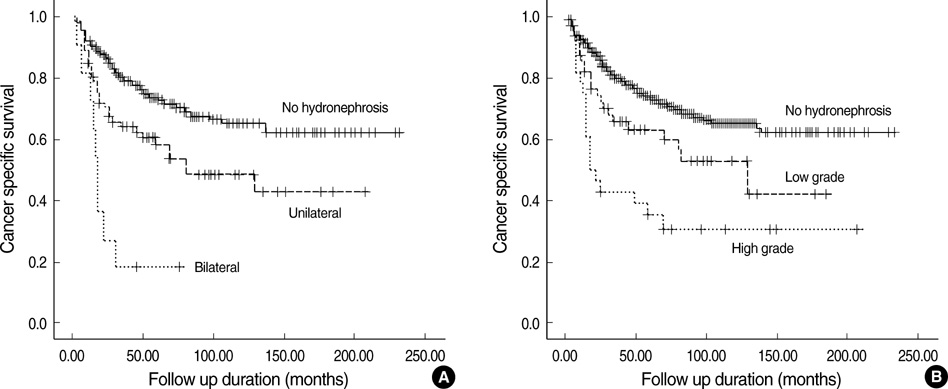J Korean Med Sci.
2010 Mar;25(3):369-373. 10.3346/jkms.2010.25.3.369.
High-Grade Hydronephrosis Predicts Poor Outcomes After Radical Cystectomy in Patients with Bladder Cancer
- Affiliations
-
- 1Department of Urology, Urological Science Institute, Yonsei University College of Medicine, Seoul, Korea. sjhong346@yuhs.ac
- 2Department of Pathology, Yonsei University College of Medicine, Seoul, Korea.
- 3Department of Diagnostic Radiology, Yonsei University College of Medicine, Seoul, Korea.
- KMID: 1778030
- DOI: http://doi.org/10.3346/jkms.2010.25.3.369
Abstract
- We examined whether the presence and severity of preoperative hydronephrosis have prognostic significance in patients who underwent radical cystectomy for transitional cell carcinoma of the bladder. The medical records of 457 patients who underwent radical cystectomy for bladder cancer between 1986 and 2005 were retrospectively reviewed. Following the Society for Fetal Urology grading system, patients were divided into low-, and high-grade hydronephrosis groups. Clinicopathologic factors associated with preoperative hydronephrosis and survival were evaluated. Of a total of 406 patients, unilateral hydronephrosis was found in 74 (18.2%), bilateral hydronephrosis in 11 (2.7%), and no hydronephoris in 321 (79.1%). Low-grade hydronephrosis was found in 57 (12.2%) patients and high-grade hydronephrosis in 28 (6%). Preoperative hydronephrosis was related to higher pT stage and lymph node invasion. In univariate analysis, the presence of hydronephrosis, hydronephrosis grade, age, pT and pN stage, tumor grade, surgical margin, number of retrieved nodes, carcinoma in situ, and lymphovascular invasion were significant prognostic factors for cancer-specific survival. In multivariate analysis, bilateral hydronephrosis and high-grade hydronephrosis remained significant predictors for decreased survival. The presence of preoperative hydronephrosis, and high-grade hydronephrosis are significant prognostic factors in patients with bladder cancer after radical cystectomy.
MeSH Terms
-
Adult
Aged
Carcinoma, Transitional Cell/diagnosis/*mortality/pathology/*surgery
*Cystectomy
Female
Humans
Hydronephrosis/classification/*pathology
Male
Middle Aged
Multivariate Analysis
Prognosis
Retrospective Studies
Survival Rate
Treatment Outcome
Urinary Bladder Neoplasms/diagnosis/*mortality/pathology/*surgery
Figure
Reference
-
1. Leibovitch I, Ben-Chaim J, Ramon J, Madjar I, Engelberg IS, Goldwasser B. The significance of ureteral obstruction in invasive transitional cell carcinoma of the urinary bladder. J Surg Oncol. 1993. 52:31–35.2. Bowles WT, Silber I. Carcinoma of the bladder: a computer analysis of 516 patients. J Urol. 1972. 107:245–247.
Article3. Haleblian GE, Skinner EC, Dickinson MG, Lieskovsky G, Boyd SD, Skinner DG. Hydronephrosis as a prognostic indicator in bladder cancer patients. J Urol. 1998. 160:2011–2014.
Article4. Bartsch GC, Kuefer R, Gschwend JE, de Petriconi R, Hautmann RE, Volkmer BG. Hydronephrosis as a prognostic marker in bladder cancer in a cystectomy-only series. Eur Urol. 2007. 51:690–698.
Article5. Scrimger RA, Murtha AD, Parliament MB, Venner PM, Hanson J, Houle G, Chetner M. Muscle-invasive transitional cell carcinoma of the urinary bladder: a population-based study of patterns of care and prognostic factors. Int J Radiat Oncol Biol Phys. 2001. 51:23–30.
Article6. Bassi P, Ferrante GD, Piazza N, Spinadin R, Carando R, Pappagallo G, Pagano F. Prognostic factors of outcome after radical cystectomy for bladder cancer: a retrospective study of a homogeneous patient cohort. J Urol. 1999. 161:1494–1497.
Article7. Thrasher JB, Frazier HA, Robertson JE, Dodge RK, Paulson DF. Clinical variables which serve as predictors of cancer-specific survival among patients treated with radical cystectomy for transitional cell carcinoma of the bladder and prostate. Cancer. 1994. 73:1708–1715.
Article8. Fernbach SK, Maizels M, Conway JJ. Ultrasound grading of hydronephrosis: introduction to the system used by the Society for Fetal Urology. Pediatr Radiol. 1993. 23:478–480.
Article9. Stein JP, Lieskovsky G, Cote R, Groshen S, Feng AC, Boyd S, Skinner E, Bochner B, Thangathurai D, Mikhail M, Raghavan D, Skinner DG. Radical cystectomy in the treatment of invasive bladder cancer: long-term results in 1054 patients. J Clin Oncol. 2001. 19:666–675.
Article10. Karakiewicz PI, Shariat SF, Palapattu GS, Gilad AE, Lotan Y, Rogers CG, Vazina A, Gupta A, Bastian PJ, Perrotte P, Sagalowsky AI, Schoenberg M, Lerner SP. Nomogram for predicting disease recurrence after radical cystectomy for transitional cell carcinoma of the bladder. J Urol. 2006. 176:1354–1362.
Article11. Yang MH, Yen CC, Chen PM, Wang WS, Chang YH, Huang WJ, Fan FS, Chiou TJ, Liu JH, Chen KK. Prognostic-factors-based risk-stratification model for invasive urothelial carcinoma of the urinary bladder in Taiwan. Urology. 2002. 59:232–239.
Article12. Canter D, Guzzo TJ, Resnick MJ, Brucker B, Vira M, Chen Z. Hydronephrosis is an independent predictor of poor clinical outcome in patients treated for muscle-invasive transitional cell carcinoma with radical cystectomy. Urology. 2008. 72:379–383.
Article13. Keays MA, Guerra LA, Mihill J, Raju G, Al-Asheeri N, Geier P, Gaboury I, Matzinger M, Pike J, Leonard MP. Reliability assessment of society for fetal urology ultrasound grading system for hydronephrosis. J Urol. 2008. 180:1680–1683.
Article
- Full Text Links
- Actions
-
Cited
- CITED
-
- Close
- Share
- Similar articles
-
- Predicting Progression and Survival in Korean Patients with High Grade T1 Bladder Cancer Using EORTC Risk Tables
- Continent ileal reservoir after radical cystectomy for bladder tumor
- Safety of Adjuvant Chemotherapy after Orthotopic Bladder Substitution: Comparison to Ileal Conduit
- Urethral Recurrence of Bladder Tumor after Total Cystectomy
- Current Evidence for the Treatment of Bladder Cancer


